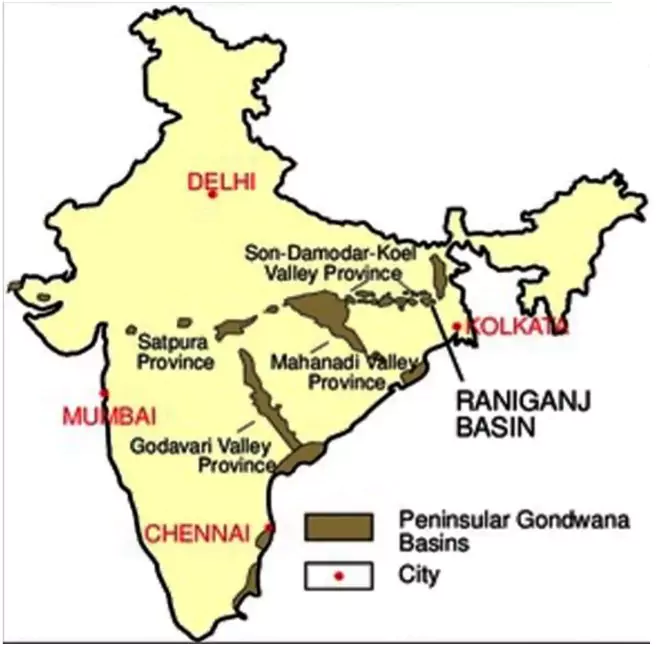Core Demand of the Question
- State reasons for the mining sector’s low GDP contribution despite rich mineral resources.
|
Answer
Introduction
India’s Gondwanaland legacy has endowed it with vast mineral wealth like coal, iron ore, and bauxite. Yet, the mining sector contributes merely ~2% to GDP, highlighting the underutilisation of geological potential due to various reasons.

Body
Reasons for the mining sector’s low GDP contribution despite rich mineral resources
- Geographical Factors
- Resource-Rich but Remote Locations: Many mineral belts like Chota Nagpur plateau, Bastar, and Singhbhum are in difficult terrain with poor accessibility. This limits exploitation and integration with national markets.
- Deep-Seated and Uneconomical Deposits: Many untapped reserves are located at great depths, making them commercially non-viable with current technologies. Exploration remains restricted to shallow, easily accessible sites.
- Environmental Factors
- High Ecological Sensitivity: Forest-rich mineral zones are ecologically fragile, such as in central India, leading to frequent environmental opposition. Hence, clearance delays reduce sectoral contribution to GDP.
- Stricter Environmental Norms: Increasing global and national pressure for sustainable mining limits scale and speed of mining operations. This restricts aggressive industrial expansion in the sector.
- Political and Policy Factors
- Policy Overlaps: Mineral rights fall under both central and state purview, creating coordination challenges and policy uncertainty. Investors face fragmented governance.
- Policy Instability: Repeated amendments to the MMDR Act, royalty changes, and retrospective taxation discourage long-term planning. Inconsistent regulations hurt mining’s GDP share.
- Infrastructure Factors
- Poor Connectivity and Power Supply: Mining belts often suffer from underdeveloped road, rail, and power infrastructure. Transporting bulk minerals becomes costly and inefficient.
- Limited Processing Facilities: Absence of local beneficiation units forces raw material export instead of value addition. This results in missed GDP gains from downstream industries.
- Other Factors
-
- Insurgency and LWE Areas: Mineral-rich regions like Dantewada and Sukma remain affected by Left-Wing Extremism. Though most of the concerns have been addressed, lingering security threats deter industrialisation.
- Global Commodity Volatility: Mining is highly sensitive to international price fluctuations, leading to unstable returns. This discourages aggressive expansion.
Way Forward
- Simplify Clearances to Attract Investment: Introduce a unified and time-bound clearance system to reduce project delays and attract private and foreign investment. Increased mining activity boosts industrial output and contributes directly to GDP growth.
- Exploration and Technology: Increase investment in deep exploration using modern technologies. Increased mining activity boosts industrial output and contributes directly to GDP growth.
- Infrastructure Development: Develop dedicated mineral transport corridors. Dedicated rail and road links will ensure efficient evacuation of minerals, reduce logistics cost, and make Indian mining globally competitive.
- Promote Domestic Mineral-Based Industries: Set up downstream units like steel and aluminium plants near mining clusters via industrial corridors. Local value addition multiplies economic output, boosting the mining sector’s indirect contribution to GDP.
- Leverage Tribal Participation: Implement fair compensation and skill-based employment models for tribals in mining regions under PESA and FRA. Greater local participation ensures operational continuity, reducing socio-political disruptions that limit GDP contribution.
- Environmental Sustainability: Mandate scientific mine closure and ecological restoration. Sustainable mining ensures long-term productivity and avoids economic losses from regulatory shutdowns.
Conclusion
India, being one of the countries of Gondwanaland, has endowed it with rich mineral reserves. While the geological advantage exists, its economic potential remains underutilised due to above reasons. A holistic and coordinated approach involving all stakeholders is essential to unlock this latent potential and align the sector with India’s broader economic growth ambitions.
To get PDF version, Please click on "Print PDF" button.


Latest Comments